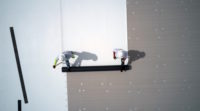Q: Why is water management crucial to roof performance?
A: Effective water shedding is considered one of the primary functions of a long-lasting, high-performance roof. Ponding water is one of the greatest threats to a low-slope roof assembly: it shortens the service life of the roof and can lead to serious problems such as leaks. It also imposes additional structural load, especially when frozen. If the roof is unable to handle the stress, it can potentially cause deck deflection and compromise structural integrity. Timely and efficient water drainage can prevent these issues, reducing high maintenance costs and ensuring continued performance along with the safety of building occupants.
Q: How does tapered roof insulation help improve drainage and reroofing challenges?
A: First off, it is important to remember that the roof’s ability to shed water effectively depends more on the assembly's ability to control water flow and direct it toward proper drainage devices than on the membrane itself. When roofs have insufficient drainage slopes, design teams can employ a tapered roof insulation system to create slopes in any direction and nearly eliminate the risk of ponding water. The system can also be used to address limiting rooftop conditions, such as low curb or flashing heights, or proximity of door thresholds and window sill heights to the finished roof surface, which may not be easily solved by flat stock insulation.
Tapered roof insulation is particularly useful in roof retrofit projects, where changing the roof's structure to achieve proper drainage would be impractical or expensive. In any case, the design of each tapered insulation system is governed by the footprint and complexity of the roof, including the slope of the roof deck, configuration of primary and secondary roof drains, scuppers, and roof edge conditions (i.e., the height of parapet walls or presence of gutters or drip edges). To ensure performance, design teams should consult the insulation manufacturer, particularly for non-standard slope profiles and additional assistance with system design options and recommendations.

Q: Can tapered roof insulation help design teams meet energy-code requirements?
A: Absolutely. Today, building energy codes and performance standards require new roofing systems – whether installed on new or existing buildings – to meet minimum R-value requirements for above deck roof insulation. So, if local codes stipulate a minimum R-30 for roof insulation, the tapered roof insulation can work in tandem with flat stock roof insulation to meet the overall requirement. In many instances, the use of a polyisocyanurate tapered insulation design, an optimized insulation design or the addition of other features such as roof drains, may be used to improve roof system configuration and accommodate the required levels of roof insulation.
Because tapered polyiso roof insulation is a rigid foam board with an inherently water-resistant core and has one of the highest R-values per inch compared to other insulating options, it can help design teams achieve roof systems that comply with codes and ensure high performance.
Q. What are some best practice recommendations for project teams when specifying roofing systems?
A: In addition to high performance, roof assemblies need to be durable. They should be able to handle the impact of heavy foot traffic and climate extremes (such as hail or high winds). For this, including roof cover boards in all low-slope membrane roof systems provides a suitable substrate for membrane attachment and improves the system’s overall resilience. Leveraging polyiso’s proven performance, high-density (HD) polyiso roof cover boards are a high-performance solution. They are 66-80 percent lighter than gypsum products and hence easier to handle and install. Furthermore, HD polyiso cover boards deliver two- to five-times higher R-value compared to gypsum products (typically, R-2.5 for 0.5” thick HD polyiso roof cover boards). With excellent compressive strength, HD polyiso roof cover boards bolster a roof’s ability to withstand weather events and service traffic, thereby extending the service life of the entire assembly.
Justin Koscher is the president of the Polyisocyanurate Insulation Manufacturers Association (PIMA). For detailed insights into the application and best practices of tapered polyiso roof insulation, refer to PIMA’s latest report, ‘Strategies for Roof Replacement Projects with Insulation Entirely Above Deck’ or visit polyiso.org for more information.




